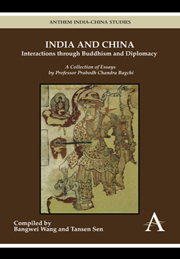 India and China: Interactions through Buddhism and Diplomacy
India and China: Interactions through Buddhism and Diplomacy Indian Civilization in China
from Part Three - Articles in Bengali
Published online by Cambridge University Press: 05 March 2012
Summary
It is quite unnecessary to remind the readers to take a fresh look at the close association that existed between India and China in the ancient period. The India-China contacts dating back to the second century before the Christian Era, occupies a major part of Indian history, though many of us are oblivious of this. Nevertheless, the knowledge of our past history contributes to a great extent towards the reconstruction of India by stringing together the lost links of our cultural ties.
The name Cina (Chin) attributed to China was introduced by India to the outside world. The Chinese people call their country by a different name. Even in the bygone days the Chinese used a different name for their country. Qin dynasty ruled China is the third century B.C. and according to the tradition the country was called Cinadesh after the name of the ruling dynasty. Despite the succession in the ruling dynasty and the subsequent change in the name of the country, the Indians maintained the previous name i.e., Cina. It is interesting to note that in the early Greek literature China has been referred to as Sinae, Thinae, etc.
Prior to the establishment of democracy in China, the elite class of China used to be called “Mandarin”. The spoken language of the people living in Peking, the capital, used to be called “Mandarin”. This word is a modified form of the Sanskrit word mantrin.
- Type
- Chapter
- Information
- India and China: Interactions through Buddhism and DiplomacyA Collection of Essays by Professor Prabodh Chandra Bagchi, pp. 205 - 208Publisher: Anthem PressPrint publication year: 2011


